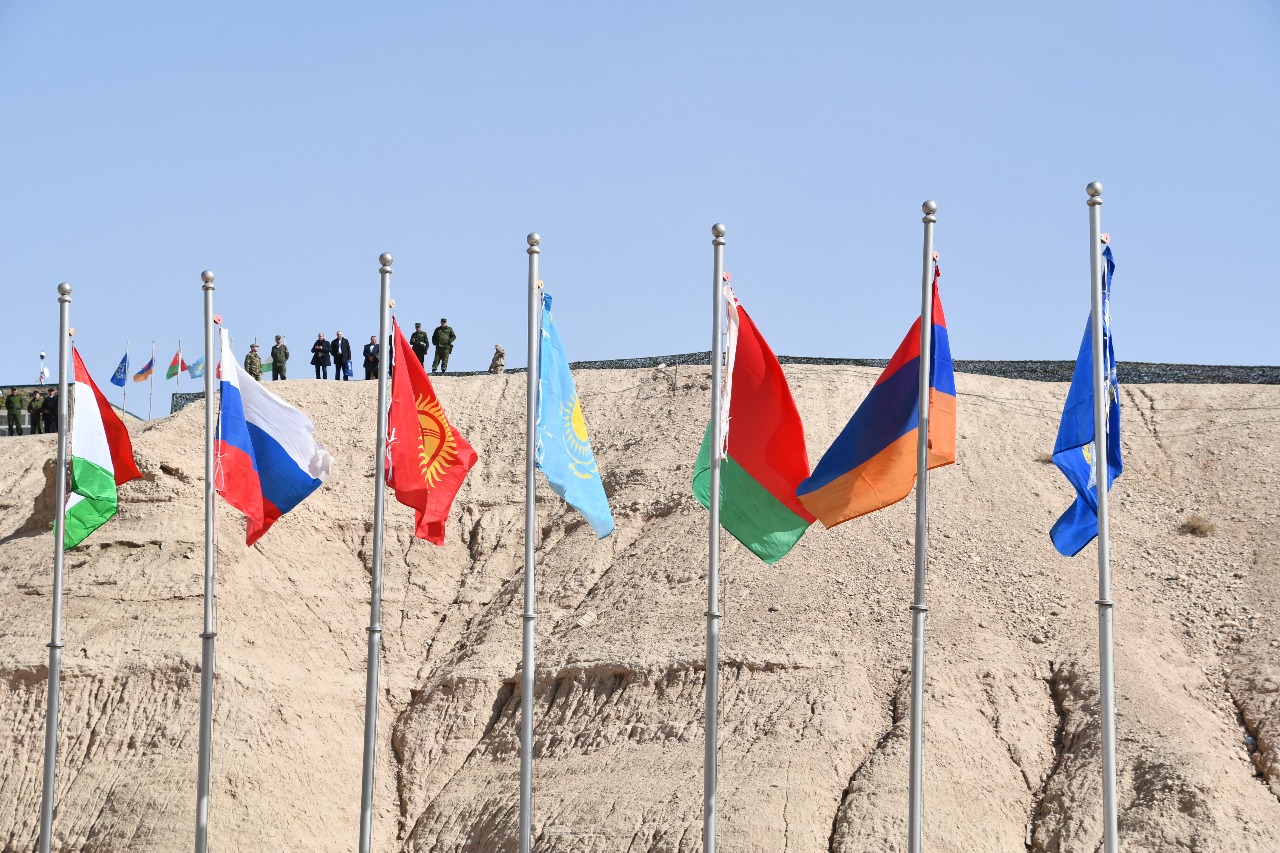A nation must think before it acts.
The governments in Central Asia are treading cautiously in their remarks about Russia’s invasion of Ukraine. Central Asia, too, was part of the Russian Empire and Soviet Union, and, when some in Central Asia see the news from Ukraine, they might wonder if they are seeing their own future. That worrying thought must have crossed the minds of some officials in the Central Asian governments as well.
Officials in Kazakhstan, and, more recently, in Uzbekistan, have stated that their governments will not recognize the independence of the Kremlin-backed separatist regions of Donetsk and Luhansk, as President Vladimir Putin announced Russia would do on February 21. Tashkent and Nur-Sultan have also called for an end to the violence in Ukraine but avoided any mention of the aggressor.
There are reasons why the leadership in Kazakhstan and Uzbekistan—or in Kyrgyzstan, Tajikistan, or Turkmenistan for that matter—would not criticize Russia’s military campaign in Ukraine, principally because their ties with Moscow are too important to risk. The Russian labor market is a vital source of employment for many Central Asians; Russia plays key roles in the energy, and energy export, sectors of Central Asia; and Russia remains the guarantor of security in the region.
Reliance on Russia for Migrant Labor Remittances
Several million Central Asian migrant laborers work in Russia. Most are from Kyrgyzstan, Tajikistan, and Uzbekistan. The money that these workers send back to their families is indispensable to the economies of those three countries, making up, respectively, some 31, 27, and 12 percent of their gross domestic products. These migrant laborers have few options as to where they can legally find work, and Russia remains their principal destination.
The plummet of the ruble’s value in the wake of Russia’s invasion will hit Central Asia hard. The World Bank forecasts the value of remittances from Russia will drop in Uzbekistan by 21 percent, in Tajikistan by 22 percent, and in Kyrgyzstan by 33 percent.
Recent history suggests most Central Asians will continue to go to Russia for work as they did during the 2008 global economic crisis, the 2014 campaign in eastern Ukraine when the Kremlin fell under Western sanctions for its support of separatists in the Donetsk and Luhansk regions, the years after 2015 when the sharp drop in global oil prices hurt the Russian economy, and the recent COVID pandemic.
Most Central Asian migrant laborers are engaged in menial jobs such as construction or factory work, working in restaurants, driving taxis, or shoveling snow off streets in winter. Russia is need of such workers, and it is easier for Central Asian migrants laborers to travel to, and work legally in Russia, than in most other countries.
The governments in Kyrgyzstan, Tajikistan, and Uzbekistan will be anxious that their citizens continue to go to Russia for work as there are no jobs available at home and swelling numbers of unemployed bring the risk of social unrest. These governments cannot handle having all of their nationals returning from Russia.
Kazakhstan and Kyrgyzstan are members of the Russian-led Eurasian Economic Union (EAEU). For Kyrgyzstan, in particular, this has been an advantage. Some 650,000 migrant laborers in Russia are from Kyrgyzstan, nearly one-tenth of the population. It is easier for citizens of an EAEU member state to obtain a work permit in Russia—or at least it is supposed to be—than for citizens of Tajikistan and Uzbekistan, which are not a part of the EAEU; Kyrgyz citizens also have access to Russia’s healthcare system. Work that Kyrgyz citizens do in Russia also counts towards their pensions under EAEU legislation. And Bishkek seems to have reached an agreement with Moscow to exempt Kyrgyzstan from a recent Russian export ban on essential goods that came in response to international sanctions. According to Kyrgyz Economics Minister Eldar Alisherov, under EAEU guarantees to ensure food security for member states, Kyrgyzstan will continue vital imports of Russian grain despite the ban Moscow announced on March 14 on exports of wheat, rye, barley, maize, and sugar to EAEU countries.
Reliance on Russia for Security
Russia has long been seen as the guarantor of security in Central Asia. Since the Taliban regained control over Afghanistan in August 2021, that role has become more important. Russian troops have participated in joint military and counter-terrorism exercises in Kazakhstan, Kyrgyzstan, Tajikistan, and Uzbekistan. Most of the Central Asian governments have established an amicable dialogue with the Taliban, but there are also Central Asian citizens in militant groups in Afghanistan over which the Taliban have little, or in the case of the Islamic State of Khorasan, no control.
Tajikistan has not engaged with the Taliban and has maintained a cold, and, at times, hostile position toward the Afghan militant group. Both sides have reinforced their troops along the Tajik-Afghan border, and Tajik officials have claimed that there are several thousand foreign (non-Afghan) militants just over the border in northeastern Afghanistan. The Tajik government’s unique stance on the Taliban is almost surely emboldened by the presence of Russia’s 201st Division, which continued to be stationed in Tajikistan after the collapse of the Soviet Union. Russia and Tajikistan signed a lease in 2012 that allows the 201st Division to remain at its bases in Tajikistan until 2042.
Kazakhstan, Kyrgyzstan, and Tajikistan are members of the Russian-led Collective Security Treaty Organization (CSTO). There is a CSTO base under Russian command at Kant, Kyrgyzstan, some 40 kilometers from Bishkek. The CSTO conducted exercises with Central Asian member states in the wake of the Taliban’s reconquest of Afghanistan, including drills in Tajikistan near the Afghan border.
The CSTO sent troops to guard strategic facilities in Kazakhstan in January 2022 when unrest broke out and there was seemingly an attempt to overthrow President Kassym-Jomart Tokayev. This deployment marks the organization’s first during a conflict and served as a reminder to the Central Asian states of the importance of the Russian-led organization.
Reliance on Russia for Energy
Central Asia is also tied to Russia by energy infrastructure and energy export routes.
Kazakhstan’s major export is oil. The Caspian Pipeline Consortium (CPC) built a 1,500-kilometer pipeline from western Kazakhstan through which oil from three of the country’s largest oil fields—Tenghiz, Kashagan, and Karachaganak—is shipped to the Russian Black Sea port at Novorossiysk. According to the CPC website, from 2001 until January 9, 2022, nearly 669 million tons of Kazakh crude has been shipped through the CPC pipeline.
Chevron has the leading stake in the CPC pipeline, but the Russian Federation has a 24-percent stake in the consortium, and other shareholders include subsidiaries of Russian companies Lukoil and Rosneft. The recent U.S. ban on Russian oil and gas does not apply to Kazakh oil shipped through the CPC pipeline.
Lukoil is also a partner in Kazakhstan’s onshore Tenghiz and Karachaganak oil fields, and it has a 50-percent stake in Kazakhstan’s sector of the Caspian Sea in the al-Farabi, Khvalynskoye, and Zenis blocks, as well as a 25-percent stake in the Tsentralny block.
The energy grid of northern Kazakhstan and southwestern Siberia are connected, a legacy of the Soviet Union. This was important recently when Kazakhstan was able to import extra electricity from Russia after three of the largest power plants in northeastern Kazakhstan shut down in October 2021.
Kyrgyzstan sold its natural gas distribution network to Russia’s Gazprom in April 2014 for a symbolic $1. Gazprom has used gas from fields that it has developed in neighboring Uzbekistan to source the Kyrgyz network, and, by all accounts, the reliability of gas distribution in Kyrgyzstan has improved since the deal. With hydropower stations in Kyrgyzstan crippled due to a recent drought, Gazprom’s presence in Kyrgyzstan is all the more important.
Lukoil and Gazprom are Uzbekistan’s major partners in the exploration and development of gas and oil fields in Uzbek territory. The country has moved from being a gas exporter to a gas importer, and there are shortages of gas and petroleum products—largely due to a population boom since the collapse of the USSR. Uzbekistan has some 600 million barrels of oil and 800 billion cubic meters of gas, and, with further exploration, more might be found, but, without outside help, it will not be able to get those resources out of the ground.
The deals are the result of unfavorable contracts that Uzbek officials signed with Russian companies after the Andijan massacre of May 2005 when Uzbek troops opened fire on protesters, most of whom were unarmed. Western nations called for an independent investigation into the disproportionate use of force, but Russia and others supported the Uzbek government. The Uzbek government responded by closing down Western organizations and companies working in the country and gave contracts for key projects to Russian and Chinese companies. The disadvantageous nature of the deals was exposed in 2019 when Lukoil announced Uzbekistan owed some $600 million for using gas produced in Uzbekistan for domestic consumption instead of exporting it to China as Lukoil intended.
Still, Lukoil and Gazprom have operated in Uzbekistan for some 20 years and are major investors and employers in Uzbekistan’s oil and gas industry. Considering immediate needs for gas and oil, both Russian companies are vital for keeping the power and heat on.
Kyrgyzstan and Tajikistan import nearly all oil and petroleum products, and most of their imports comes from Russia. Logistically, no other oil-exporting country is in a position to fill Russia’s role in supplying petroleum products. For the same reason, in 2017, Uzbekistan reached a deal for imports of up 10 million tons of Russian oil annually after Shavkat Mirziyoyev took over as Uzbekistan’s president in late 2016 and a Soviet-era pipeline connecting the two countries through Kazakhstan was repaired to facilitate Russian oil imports.
Turkmenistan has transported some 160,000 tons of oil per month by tanker to the Russian Caspian port at Makhachkala, and then to the Black Sea port at Novorossiysk, though it appears now that Ashgabat will resume sending at least some of that oil to Azerbaijan for export through the Baku-Tbilisi-Ceyhan pipeline.
Reliance on Russia for Political Legitimacy
Russian support for transitions of power is also important in Central Asia. Turkmenistan just had a presidential election on March 12, which was won by incumbent President Gurbanguly Berdymukhammedov’s son Serdar. It was the first post-Soviet dynastic transfer of power in Central Asia, and it came after Serdar made several visits to Russia to become better acquainted with officials there.
Tajik President Emomali Rahmon has similarly been grooming his eldest son Rustam Emomali to succeed him as president, and the corruption of Rahmon’s family in the last 30 years has been such that there is little public support for the father-to-son transfer of power. Russian backing will be essential to successfully install Rustam as president.
CSTO support for Tokayev in January demonstrates the importance of Russia in propping up a member government in trouble.
Incurring Russia’s wrath—by vocally and explicitly condemning Russian actions in Ukraine—could have devastating consequences for Central Asia, and the leaders of the region understand this dynamic. That is why they act so cautiously.
Whether Russia’s military campaign in Ukraine is successful or not, Central Asia will still be closely tied to Russia for the foreseeable future, and that makes expressing an opinion on the Russian attacks on Ukraine a delicate proposition.
The views expressed in this article are those of the author alone and do not necessarily reflect the position of the Foreign Policy Research Institute, a non-partisan organization that seeks to publish well-argued, policy-oriented articles on American foreign policy and national security priorities.




